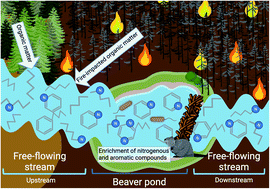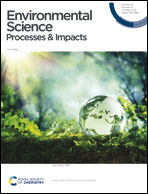Impact of beaver ponds on biogeochemistry of organic carbon and nitrogen along a fire-impacted stream†
Abstract
Wildfires, which are increasing in frequency and severity in the western U.S., impact water quality through increases in erosion, and transport of nutrients and metals. Meanwhile, beaver populations have been increasing since the early 1900s, and the ponds they create slow or impound hydrologic and elemental fluxes, increase soil saturation, and have a high potential to transform redox active elements (e.g., oxygen, nitrogen, sulfur, and metals). However, it remains unknown how the presence of beaver ponds in burned watersheds may impact retention and transformation of chemical constituents originating in burned uplands (e.g., pyrogenic dissolved organic matter; pyDOM) and the consequences for downstream water quality. Here, we investigate the impact of beaver ponds on the chemical properties and molecular composition of dissolved forms of C and N, and the microbial functional potential encoded within these environments. The chemistry and microbiology of surface water and sediment changed along a stream sequence starting upstream of fire and flowing through multiple beaver ponds and interconnecting stream reaches within a burned high-elevation forest watershed. The relative abundance of N-containing compounds increased in surface water of the burned beaver ponds, which corresponded to lower C/N and O/C, and higher aromaticity as characterized by Fourier transform ion cyclotron resonance mass spectrometry (FT-ICR MS). The resident microbial communities lack the capacity to process such aromatic pyDOM, though genomic analyses demonstrate their potential to metabolize various compounds in the anaerobic sediments of the beaver ponds. Collectively, this work highlights the role of beaver ponds as biological “hotspots” with unique biogeochemistry in fire-impacted systems.

- This article is part of the themed collection: Geochemistry


 Please wait while we load your content...
Please wait while we load your content...